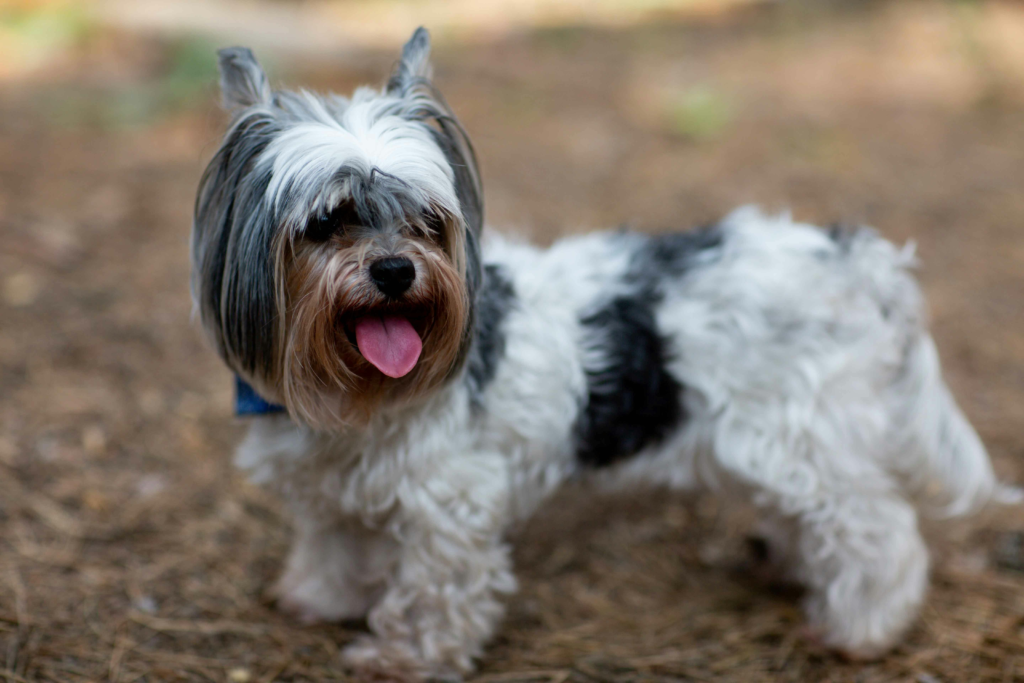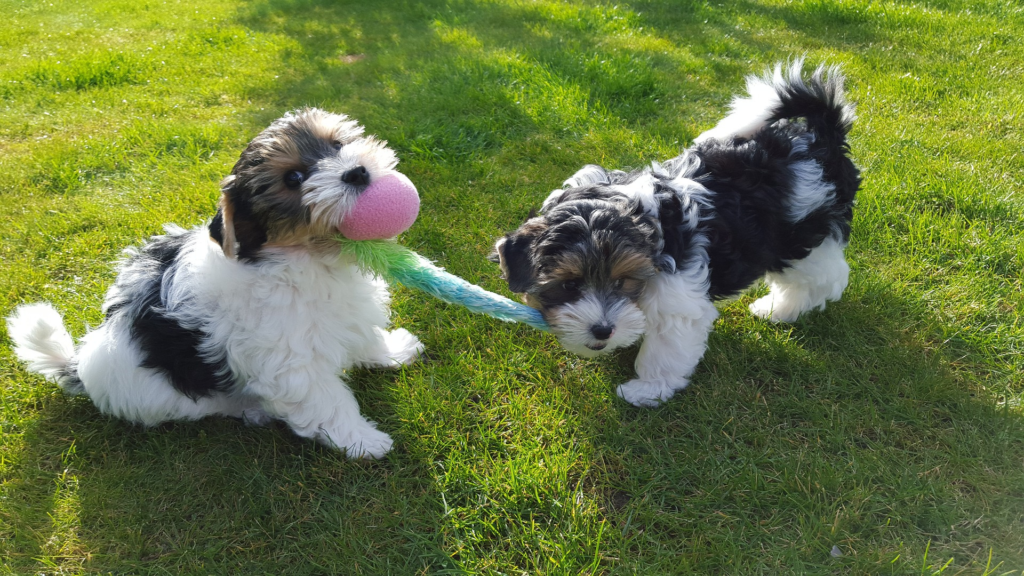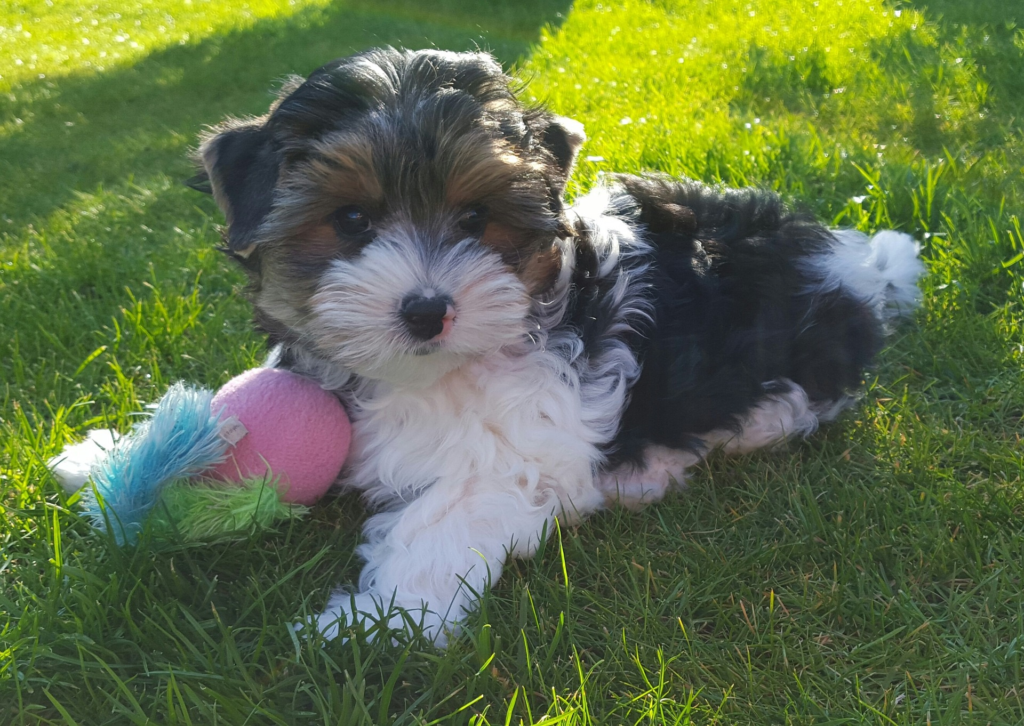Introduction:
The Biewer Terrier with its distinctive tri-colored coat and lively demeanor, is a breed that has captured the hearts of dog enthusiasts worldwide. Originating from Germany, this relatively new breed has quickly gained popularity for its unique appearance and charming personality. This article delves into the fascinating world of Biewer Terriers, exploring their history, characteristics, care requirements, and more.

Characteristics:
Biewer Terriers are small-sized dogs with a sturdy build and a confident, alert demeanor. Their tiny size allows them to easily reach and explore compact corners in the household, sometimes making it difficult for you to find your little pup.
They typically stand between 7 to 11 inches tall at the shoulder and weigh around 4 to 8 pounds. One of the Biewer Terrier’s most striking features is its long, silky, and tri-colored coat. The ideal coat colors are white, black, and gold in specific patterns, creating a visually stunning appearance.
Due to their small size, some owners have accidentally stepped on their beaver terriers in the past, leading to injuries like fractures and concussions. concussions, and sadly, even death. Remember to always be wary of your tiny Biewer to avoid such accidents.
History:
The story of the Biewer Terrier begins in the 1984s when a German couple, Werner and Gertrude Biewer, produced a tricolored puppy in their Yorkshire Terrier breeding program. This unexpected color variation sparked their interest, leading them to breed for this trait selectively.
Eventually, the Biewers succeeded in establishing a distinct breed with its standard, separate from the Yorkshire Terrier. In 1989, the Biewer Terrier was officially recognized by the Allgemeiner Club der Hundefreunde Deutschland (ACH) in Germany
There are distinct features between beaver terriers and their Yorkie ancestors. Beavers have a tri-colored coat and full tails, while Yorkies have a two-colored coat and their tails are often docked, making them easily distinguishable.
The Biewer terrier’s three-colored fur is undoubtedly their most distinguishing feature. What’s more, every beaver has a different coat pattern, so it’s super rare to find two with the same colors, making each dog practically one of a kind.
Unlike Yorkies, Biewer terriers also tend to have a more athletic physique, boasting increased muscle mass and sturdier bones. As a result, they tend to be slightly larger and weigh more. This robust build also makes beavers more energetic and playful, necessitating additional exercise and outdoor activities.
In 2007, research from the Mars Veterinary Lab confirmed that Biewer terriers are a distinct and pure breed, separate from Yorkshire terriers. It’s the first time in history that a breed was recognized as purebred through scientific research, genetic analysis, and DNA testing, rather than relying solely on traditional pedigree records.

Some people believe that the Biewer terrier wouldn’t have been recognized as its breed if they had emerged in the US instead of Germany. this is because, unlike German registrations, the American kennel club accepts tri-colored pups under the Yorkshire terrier breed.
The first Biewer terrier puppy was named Snaflurkin von Friedheck, meaning snowflakes from Friedheck. Mrs. Biewer chose this name as a tribute to her champion Yorkshire Terriers, Darling von Friedheck and Frufru von Friedheck, who are said to be the initial canine couple that gave birth to the terrier breed.
Initially, some people wondered if Darling and Fufu’s puppies might just be the result of a one-time genetic mutation. However, experts disagreed. Genetic mutations that significantly alter a breed’s appearance are quite rare.
All the subsequent pups from the litter also exhibited the same features. This suggests that these traits were intentionally developed over time, not just a random genetic fluke.
Gertrude and Werner Biewer initially referred to their puppies as black and white Yorkshire Terriers. The name was later changed to Biewer Terrier, as suggested by a German vet in honor of the breed’s creators.
In 1986, a well-known German singer, Margot Eskens, suggested adding Ela Pompon, meaning a furry ball attached on top of a hat, to the Beaver Terrier’s name. This led to the breed’s new nickname, Beaver Yorkshire Terrier Ela Pompon, highlighting the dog’s distinctive fluffy tail.
16. Biewer Terriers arrived in the US in the early 2000s and quickly became popular. This led to the creation of clubs dedicated to protecting and promoting the breed, including the formation of the Terrier Club of America.
The Biewer Terrier joined the AKC Foundation Stock Service in 2014. This program registers and tracks purebred dogs not yet eligible for regular AKC registration. You can think of it as a temporary stop on the path to full AKC recognition.
After seven years in the foundation stock, the Terrier finally gained full recognition from the AKC in 2021. The breed was added to the toy group, enabling them to participate in AKC dog shows and events.
Despite being a terrier, the Beaver Terrier does not belong to the terrier group in the AKC stud book. Their small size has earned them a spot in the toy group instead, much like the Yorkshire Terrier.
Health Considerations
Overall, Biewer Terriers are a relatively healthy breed with a lifespan of around 12 to 15 years. However, like all dogs, they are prone to certain health issues that prospective owners should be aware of. Some common health concerns in Terriers include.
Patellar Luxation: A condition where the kneecap dislocates from its normal position, causing lameness or discomfort.
Dental Problems: Small breeds like Biewer Terriers are susceptible to dental issues such as tooth decay and gum disease. Regular dental care, including brushing and dental check-ups, is essential.
Eye Problems: Biewers may be prone to eye conditions such as cataracts and retinal dysplasia. Regular veterinary exams can help detect and manage these issues early.
Biewer Terrier owners need to work closely with a reputable veterinarian to ensure their dogs receive proper medical care, vaccinations, and preventive measures to maintain optimal health.
Care Requirements:
Despite their long, flowing coats, Biewer Terriers are relatively low-maintenance when it comes to grooming. Regular brushing is necessary to prevent matting and tangles, but their coats do not require trimming or clipping. Additionally, occasional baths and routine grooming sessions are sufficient to keep them looking their best.
Like all dogs, Biewer Terriers require regular exercise to stay healthy and happy. Daily walks, playtime, and interactive toys are essential for mental and physical stimulation. Despite their small size, Biewers are active dogs that enjoy engaging in various activities with their owners.
This long lifespan is influenced by factors like their small size, overall good health, and playful nature that promotes physical activity and mental stimulation.
While beavers shed less than many other breeds, they still require proper grooming to keep their coats healthy and prevent matting. However, minimal shedding is a positive trait for pet owners who appreciate a clean and fur-free environment.
Remember to bathe your Biewer terrier at least once a month to keep their coat healthy. Sticking to a monthly schedule is best because bathing too often can result in dandruff and dry skin.
Biewer terriers have been known to get along quite well with other pets, including cats. These guys also love having company, so getting them another furry friend as a playmate when you’re not around is a great deal.

Do note that beaver terriers are not the best match with smaller pets like hamsters and guinea pigs. You see, some individuals retain the hunting instincts of their Yorkie ancestors who once worked as rodent hunters. That’s why you must always supervise their interactions to ensure the safety of everyone involved.
Experts have noted a higher susceptibility in terriers for certain conditions like leg calf prothese disease, liver shunts, hyperglycemia, and some digestive issues. Not every beaver will experience these issues, but owners must stay watchful for them anyway.
29. Because Biewer terriers have sensitive stomachs, it’s best to feed them a diet that’s not too high in protein or fat but made with good quality ingredients. Be careful when introducing new food and always make sure that they stay hydrated, cause it can help a pup with a sensitive stomach.
Despite their tiny stature, beaver terriers make proficient watchdogs. These guys are adept at notifying their owners of any peculiar sound or activity with their surprisingly loud bark.
Biewer may occasionally display a touch of stubbornness, making training a bit tricky. Although this is not always a big problem, owners should keep this in mind so that they can respond with patience and understanding when it does arise.
Biewer terrier price.
While beaver terriers typically cost $1,000 or more, expect to pay $3,500 to $4,000 for puppies from reputable breeders, with show potential or exceptional lineage. However, the good news is that they have meager maintenance costs compared to other breeds, making them manageable companions for various lifestyles.
Biewer terrier litters typically have two to five puppies. Compared to the usual five to six puppies and other dog breeds, this smaller litter size makes breeding beaver terriers more challenging and finding their puppies a bit tougher,
always be careful of beaver breeders selling 10 to 15 puppies in a short period. There’s always a high chance that they’re operating puppy mills that prioritize profit over pup health. Remember to opt for reputable breeders for the welfare of your puppy. Alright, guys, in which of these beaver terrier facts surprised you the most? Please let us know in the comments below.